Kelp is being grown in shallow waters, such as places in Moriches Bay on an experimental basis by Stony Brook School of Marine and Atmospheric Science, to help remove nitrogen from Long Island bays and estuaries. Newsday’s Steve Langford has more. Credit: Kendall Rodriguez
NOTE: Using kelp to help reduce nitrogen in Long Island waters was the subject of Dr. Christopher Gobler's May 27th press conference at the School of Marine and Atmospheric Sciences (SoMAS) Marine Science Center at Stony Brook Southampton. This research was sponsored by Suffolk County, New York Sea Grant, the New York Farm Viability Institute, and USDA. Below are media mentions related to this announcement.
— Filed by Mark Harrington for Newsday
Southampton, NY, May 28, 2021 - Oyster farmers who helped cultivate experimental kelp beds this winter to study the seaweed’s role in nitrogen reduction will receive first-time payments billed as "nitrogen credits" for their 2021 harvest. Scientists want to advance the growing of kelp for fertilizer and to reduce harmful algae blooms.
At a presentation Thursday at Stony Brook University’s School of Marine Sciences, Christopher Gobler, a professor who operates Gobler Laboratory at the Southampton center, said the funding program would be New York’s first to offer nitrogen credit payments for kelp cultivation.
Kelp, which grows between December and May when boaters are largely off waterways, is an efficient consumer of nitrogen and carbon dioxide, and its use is becoming more widespread. Gobler said it can be an effective tool to reduce nitrogen as Suffolk awaits large-scale introduction of advanced septic systems in homes over the next 30 years. "We need solutions right now to protect water quality," he said.
The university lab has used grant money over the past three years to cultivate sugar kelp on 10 different oyster farms, producing 10,000 pounds of kelp while removing 36 pounds of nitrogen, Gobler said.
Under the program, kelp farmers, who may eventually produce more than 70,000 pounds of kelp on one-acre farms, could help extract 200 pounds of nitrogen from the waters, Gobler said, earning hundreds of dollars of credits during a season they are largely off the water.
Funding for the effort is being provided in partnership with the Peconic Bay Keeper, a conservation group. Its executive director, Peter Topping, said the group would spend thousands to fund it, through 2021 and perhaps beyond.
As reported in Newsday last month, this year’s kelp crop showed particular success in growing the winter seaweed in shallow waters, including in an oyster farm just a few hundred yards from land in Moriches Bay. Oyster farmers and lawmakers say they hope to develop a kelp market that will interest restaurants as a menu item, garden stores as fertilizer and even food manufacturers.
One important goal for wider-spread kelp cultivation around Long Island is passage of a bill pending in the State Legislature that would allow it to be grown on Suffolk County aquaculture leases in the Peconic and Gardiners bays. At present, commercial kelp cultivation is not allowed there, but is allowed in the Gobler lab pilot study.
State Assemb. Fred Thiele (I-Sag Harbor), who sponsored the state measure, and Assemb. Steven Englebright (D-Setauket), who chairs the environmental conservation committee, said the bill is a priority for this legislative session. "It’s a viable economic product," Thiele said.
Gobler said the lab has also made advances in the production of fertilizer from kelp, developing a product that has the "same nitrogen and phosphorus [content] as Miracle Gro," the popular garden fertilizer. "The next step is to scale up and make it commercially viable," he said, envisioning a day when "we won’t need to import synthetic fertilizers on Long Island."
The Southampton-based lab also has been studying the use of kelp to reduce harmful algal blooms, Gobler said. He and another scientist recently submitted a paper accepted by the peer-reviewed journal, Harmful Algae, showing that kelp can be used to "fight off the most toxic and dangerous harmful algal blooms in New York," Gobler said.
Peter Scully, deputy county executive for Suffolk County, said while advanced septic systems will eventually produce a path to large-scale nitrogen reduction in local bays and estuaries, kelp cultivation could be "one more tool in the arsenal" to combat nitrogen as those systems await deployment.
Currently only around 1,000 to 1,500 such systems have been deployed in Suffolk. Gobler said 220,000 such systems are expected to be deployed by 2050.
More Info: Newsday — A new 'set it-and-forget it' crop may help LI's aqua farmers — and its bays, too
Pilot programs around Long Island are testing kelp growth for human and cattle food, fertilizers and cosmetics. Karen Rivara, an oyster farmer who participated in the pilot, talks about her ambitions for kelp farming. Credit: Randee Daddona
— Filed by Mark Harrington for Newsday
Stony Brook, NY, May 7, 2021 - In the murky green shallows of Moriches Bay, Paul McCormick steps from his oyster skiff to walk in knee-deep water to a section of his aqua farm that holds promise for a new industry on Long Island: cultivated sugar kelp.
It’s the end of April, just weeks before harvest, and the weight of the underwater line and the long, curled ribbons of green-brown kelp show it’s a bumper crop. Indeed, the growth is so strong that the Stony Brook University marine team that helped plant it and continues to monitor the lines here and in surrounding water believes it could mark a turning point in kelp cultivation. Never has kelp grown so well in such shallow water.
"It was just an incredible experience to watch this plant grow from mere millimeters when we planted it in December to nine to 12 feet in a matter of three or four months. Amazing," said McCormick, of East Moriches, who owns Great Gun Shellfish Co.
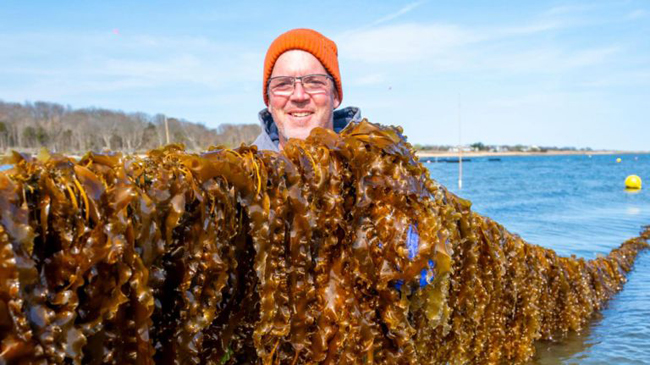
Paul McCormick, founder and owner of Great Gun Shelfish, holds a line of sugar kelp by his oyster farm on Moriches Bay in East Moriches. Credit: Randee Daddona
Scientists, lawmakers, oyster farmers and a new crop of seaweed marketers all are looking to experimental kelp farms that have dotted the waters around Long Island for the past three years with the hope for a new industry that could also be an important check on nitrogen and carbon dioxide impacts on local waterways. There’s much work to be done, advocates say, including passage of a recently introduced state law that would allow for kelp cultivation from Peconic and Gardiners bays, but momentum is building. Just last month, Montauk Seaweed Supply Co. launched a line of fertilizer products using kelp from other states and from wild kelp beds.
But kelp's uses, and its appeal, go far beyond the market for fertilizer, which is attractive as a sustainable method to add nutrients to gardens without trucking in industrial fertilizer from the outside. Kelp is sold to restaurants as a salad-like side dish, but it's used for other food products such as non-animal burgers; it's also used in soaps, shampoos and skin-care products, and is being explored for use in biofuels and sustainable packaging.
For McCormick and the eight other aqua farmers who have participated in this three-year pilot study, conducted by Stony Brook University's School of Marine and Atmospheric Sciences, the prospect of cultivating kelp represents not just another potential revenue stream but hope for a new generation of men and women who make their living on the waters.
Kelp, a long green lasagna-like sea algae that has a certain crunch and a pleasing bittersweet taste, grows in the winter, from December to May, when oyster farming goes largely dormant. It’s relatively low cost and low maintenance, particularly in waters like Moriches Bay, where McCormick is growing long lines of kelp about 100 yards from the shore near Terrell County Park. It surrounds and may even benefit his oysters.
"It’s a crop that requires low capital input, very very minimal labor — it’s basically a set it-and-forget it crop," McCormick said. "It dovetails perfectly with activity and inactivity on the shellfish farm."
Scientists studying the prospect of kelp growing off Long Island are particularly keen to its environmental benefits. It acts as a nitrogen sink, sucking up the overabundant compound, which ecologists say sometimes causes harmful algae blooms. It also absorbs CO2 and may help address acidification in waters around Long Island.
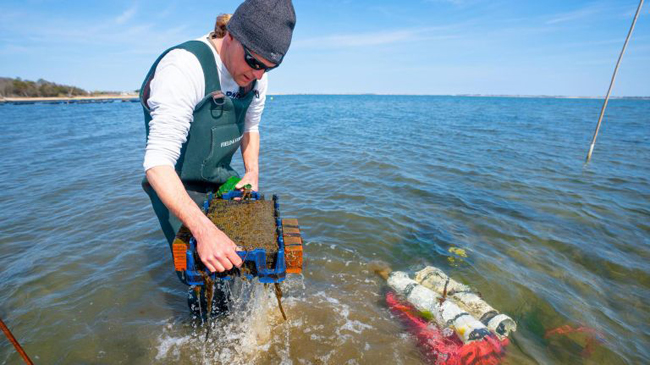
Michael Doall, associate director for bivalve restoration at Stony Brook University's School of Marine & Atmospheric Sciences, has been monitoring kelp beds for the past three years. He called such operations "restorative farming.'' Credit: Randee Daddona
Michael Doall, associate director for bivalve restoration at Stony Brook University's School of Marine & Atmospheric Sciences, has been monitoring kelp beds such as McCormick’s for the past three years, and is finding encouraging signs. He called such operations "restorative farming.''
Kelp farming across the country, in Alaska, California and the Northeast, is chiefly done in deep water — 20 feet or more, with the kelp supported by nutrients in water and anchored, but not rooted to the sea bottom. In those farms, it can be more labor and capital intensive than in shallow farms.
Doall said he and his team were surprised by the shallow farm off Moriches, which, he said, "turns out to be our best site. The quality was great. It did tremendous." Growing in shallow water costs "a fraction of what it does in deeper water."
Kelp can grow fast — and large. "The thing about kelp is ... the incredible amount of biomass you can grow in a short amount of time," Doall said. "You can almost watch it grow."
A one-acre water lease can grow 32,000 to 72,000 pounds of kelp in a five-month season, potentially netting farmers tens of thousands of dollars a year in new revenue, Doall said.
Markets for kelp — most notably as fertilizer and food — combine to yield an average price of about $1 a pound, Doall said, and in New York, those markets are just beginning to form.
McCormick said he’s been in contact with local chefs who say they’d love to buy kelp for local dishes — at prices that start at $6 a pound.
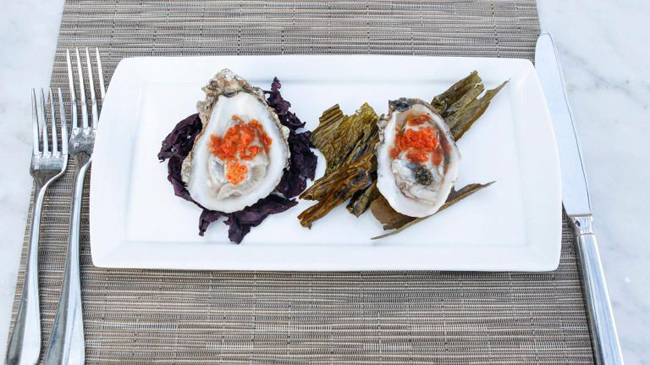
Kelp is sold to restaurants, but it's used for other food products such as non-animal burgers and in skin-care products. Here, it's served with oysters at Jedediah Hawkins Inn and Restaurant in Jamesport in 2013. Credit: Randee Daddona
One challenge is that newly harvested kelp has to get to market quickly because it doesn’t store well. Unless it's dried or blanched and frozen, it can deteriorate in a matter of days, losing its characteristic crunch and taste, Doall said.
Legislative hurdles
The market won’t develop until kelp passes a couple of critical hurdles, one of them legislative. Just this month, Long Island members of the state Legislature introduced an addition to an existing aquaculture bill that would pave the way for oyster farming to include kelp. Sen. Todd Kaminsky (D-Long Beach), who introduced the Senate version along with Sen. Anthony Palumbo (R-New Suffolk), said the amendment was fundamentally as simple as adding the words "and kelp" to the existing law. Potential kelp farmers and conservationists have been working with Assemb. Fred Thiele (I-Sag Harbor) on an Assembly version, which he said would be introduced this week. "I think there is great economic and environmental potential for kelp," Thiele said.
If the bill is signed into law, it will make cultivation of kelp from Suffolk County aquaculture leases in Peconic and Gardiners bays legal. Proponents hope it’s in place next year.
"There are so many environmental benefits that it makes sense to clear the way for kelp growers," Kaminsky said. "Other states are ahead of where we are in building this industry."
Imports and wild kelp
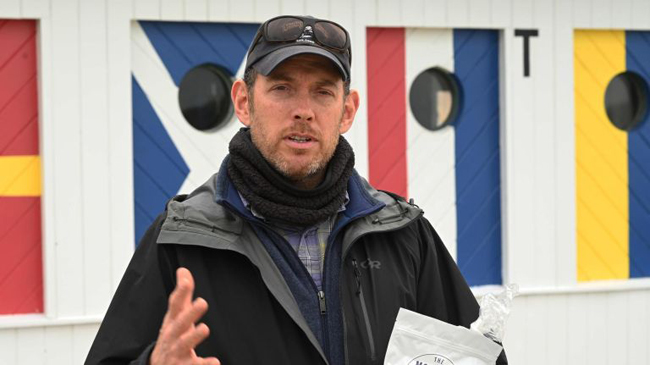
Sean Barrett founded Montauk Seaweed Supply Co., which markets kelp-based fertilizers. Credit: Mark Harrington
Some who see a big market for kelp and other seaweed products say there’s no need to wait for the bill passage to get the market going. Sean Barrett, a Montauk fisherman who started Dock to Dish, a Montauk community fishery organization, launched a company this month that began marketing kelp-based fertilizers under the Montauk Seaweed Supply Co. brand.
Barrett is buying his kelp not only from harvesters who are already legally cultivating and selling kelp in markets from Connecticut to Maine, but using divers to harvest wild kelp and other seaweeds from New York State waters. The state Department of Environmental Conservation, he said, is aware of his efforts.
In a statement, the DEC said it has "not participated in or assisted with determining locations for wild kelp harvest," but noted, "The harvest of wild kelp is not regulated by DEC and has not been pursued to date." The agency and local partners are "working collaboratively to identify kelp research and monitoring projects that will help [us] better understand potential impacts on New York’s marine ecosystem and marine life.".
Unlike wild kelp, the DEC does regulate cultivated kelp and other seaweeds in New York waters and requires an "on/off bottom culture permit" from the agency. The permit allows a holder to sell the cultivated products from their water farms, so long as the sale complies with state Department of Agriculture and Markets requirements that regulate food processing facilities and retail stores, DEC said.
"It’s impossible for the kelp industry to begin in New York State if you rely just on farmed kelp," Barrett said. When this year’s pilot crop is harvested, "there won’t be another lick of kelp available until [next] May, even with the most advanced storage capacity. You’ll never be able to start businesses with something with a two-week harvest window, and then nothing."
The "runway" for the industry is wild kelp, Barrett said. Wild kelp, which includes an invasive species from Japan, is available "pretty much year-round," he said, adding that hand harvesting can be beneficial to some seaweed-choked waters, and that his is done in a "very responsible" and limited way.
Not all are convinced that using wild kelp to kick start the industry is the way to go. Doall said he doesn’t support it, in part because wild kelp is in such short supply and it could disrupt wild habitat, not just for kelp but species that thrive in it.
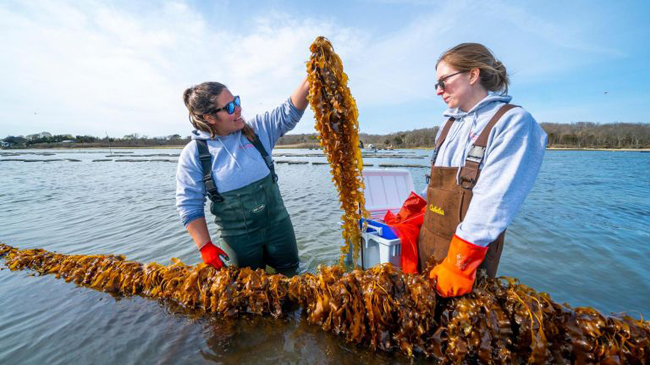
Marissa Velasquez, field restoration specialist, left, and Brooke Morrell, restoration monitoring specialist from Stony Brook University, harvest kelp growing at Great Gun Shellfish in Moriches Bay. Credit: Randee Daddona
Doall acknowledges, however, that kelp farming faces challenges, including a dearth of processors to dry or freeze the kelp to make it shelf-stable, and the limited availability of seed stock.
But the promise of kelp cultivation and its benefits for the local waters could help nudge commercial and academic funding to launch efforts to invest in seed cultivation. Christopher Gobler, chairman of Coastal Ecology and Conservation at the School of Marine and Atmospheric Sciences at Stony Brook University, said the pilot programs have grown kelp on 10 oyster farms over the past three years. He’s working on a kelp feasibility study "to get a sense of how this might be integrated into the Suffolk aquaculture program."
Suffolk County leases out about 780 acres of Peconic and Gardiners bay bottom, about 300 of which are actively farmed by oyster companies. In March, the county approved the rights to lease 600 more acres over the next decade.
Suffolk funded the $200,000 pilot studies under Gobler. A senior Suffolk official familiar with the program said the county is closely watching the results.
"We want to make sure before we permit widespread use that it actually grows in our waters," said the official. The county is preparing a study of the pilot program, which included five sites starting in December; four made it through the end of the growing season. "The industry wants it done yesterday," the official said.
Boating obstacles
The only potential opponents of kelp farming could be those who had a problem with floating gear in those waters. Some recreational boaters have previously sued over the issue in the Peconic. They’ve since resolved their differences, but Suffolk doesn’t want a repeat.
Kelp farming generally takes place five to six feet below the surface, usually deep enough to prevent interfering with most sailboats. Most of the farming takes place in the winter, when boating is minimal.
Doall of Stony Brook University said it’s not just recreational boaters who have issues with aquaculture. Some commercial fishermen have had issues with it, and there’s a level of not-in-my-backyard mentality from homeowners who live close to the near-shore farms.
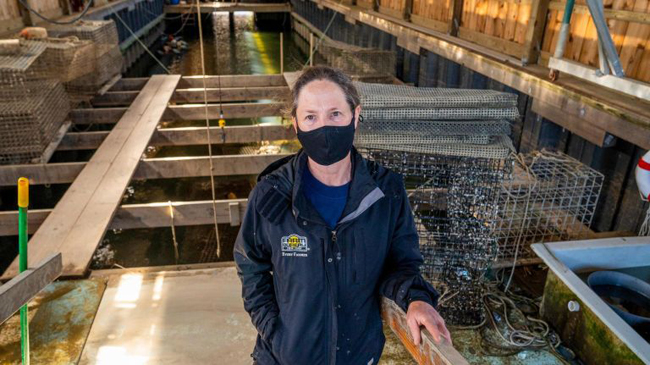
Karen Rivara, owner of Aeros Cultured Oyster Co. in Southold, was among the participants in a three-year kelp study by Stony Brook University's School of Marine and Atmospheric Sciences. Credit: Randee Daddona
Karen Rivara, an oyster farmer and president of Aeros Cultured Oyster Co. in Southold, participated in the pilot. Her kelp was in deeper waters of the Peconic Bay. She’s involved chiefly for environmental, not commercial, reasons, she said. Her farm was one of five that didn't last through the winter.
"I can’t have it suck money out of my company, but I’d like to be able to find a way to grow it so the focus is substantially environmental as opposed to just business," she said, noting she plans to offer it to a cousin who has a dairy farm. "If it ends up being feed for livestock I’m OK with that" given the environmental benefits.
Gobler of Stony Brook University said the ability to protect oysters could prove to be an important benefit of kelp for harvesters like Rivara.
"It may well be that this is something that keeps the oysters happy, creates this halo effect of combating acidification, they can even fight harmful algae blooms," he said. "We have data to show it can be a strong deterrent" to a bloom that occurs even in cold temperatures.
Meanwhile, harvesters and marketers like Montauk Seaweed Supply are moving ahead.
"Fast forward this time next year, with kelp farming in the Peconic and Gardiners bay legalized, I’d say you’ll see 20 or more oyster growers starting to cultivate much larger kelp spools and seed," Barrett said. "I think this is a huge, important step forward, and we’re ready to take it.
More Info: New York Sea Grant
New York Sea Grant (NYSG), a cooperative program of Cornell University
and the State University of New York (SUNY), is one of 34 university-based
programs under the National Oceanic and Atmospheric Administration’s
National Sea Grant College Program.
Since 1971, NYSG has represented a statewide network of integrated
research, education and extension services promoting coastal community
economic vitality, environmental sustainability and citizen awareness
and understanding about the State’s marine and Great Lakes resources.
Through NYSG’s efforts, the combined talents of university scientists
and extension specialists help develop and transfer science-based
information to many coastal user groups—businesses and industries,
federal, state and local government decision-makers and agency managers,
educators, the media and the interested public.
The program maintains Great Lakes offices at Cornell University, SUNY
Buffalo, SUNY Oswego and the Wayne County Cooperative Extension office
in Newark. In the State's marine waters, NYSG has offices at Stony Brook
University in Long Island, Brooklyn College and Cornell Cooperative
Extension in NYC and Kingston in the Hudson Valley.
For updates on Sea Grant activities: www.nyseagrant.org has RSS, Facebook, Twitter, Instagram, and YouTube links. NYSG offers a free e-list sign up via www.nyseagrant.org/nycoastlines for its flagship publication, NY Coastlines/Currents, which is published quarterly.